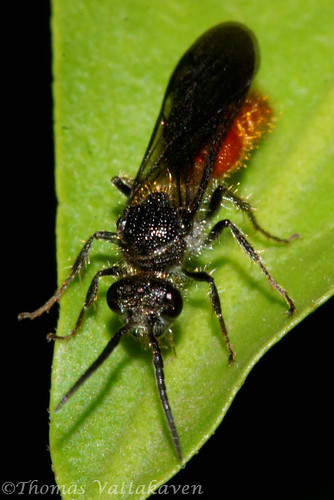Thread subject: Diptera.info :: South Indian wasp ID?
Posted by thom_vee on 15-05-2010 12:58
#1
Hi folks, I guess this is some kind of a wasp. Can anone ID this for me. Also, can anyone help explain whats going on in the second image? I`ve seen this many times. The wasps fly around from leaf to leaf in this position. Is this mating or predation? or something else?
1.

2.

Edited by thom_vee on 16-05-2010 03:32
Posted by Sundew on 15-05-2010 13:52
#2
Hi Thomas and welcome to the forum,
This is a wasp indeed, and the second photo reminds me of Australian wasps that have wingless small females and copulate after having caught them. However, it is urgently needed to give the locality of the observations - country first, and then habitat (e. g. oak wood, near lake, etc.). Otherwise the true experts (I'm none) can't decide.
Regards, Sundew
Posted by thom_vee on 15-05-2010 15:53
#3
Sundew wrote:
Hi Thomas and welcome to the forum,
This is a wasp indeed, and the second photo reminds me of Australian wasps that have wingless small females and copulate after having caught them. However, it is urgently needed to give the locality of the observations - country first, and then habitat (e. g. oak wood, near lake, etc.). Otherwise the true experts (I'm none) can't decide.
Regards, Sundew
hi sundew, Thanks for the quick reply. Thats fascinating.This wasp image was taken in Kerala,South India. This was taken in my back garden. Its mostly seen around one particular plant, I`m not sure what the plant species is but I could take a picture and post it if that helps.
Posted by Sundew on 15-05-2010 19:37
#4
Well, I don't think that the wasps have a particular affinity to that plant. They obviously like the smooth, hairless leaves that are good to run on :D. That makes hunting or female catching easier. Or did you see that they feed on nectar supplied by the flowers of that plant?
You should change the title of your thread to "South Indian wasp ID" (use the "edit" button) to attract the wasp experts. I hope there will be some that know your country and its insects.
Enjoy the forum,
Sundew
Posted by cthirion on 15-05-2010 22:48
#5
Probably Scolioidea
Posted by Graeme Cocks on 16-05-2010 03:46
#6
The family of Australian wasps with wingless females is Thynnidae (previously Tiphiidae), but it does look more like Scoliidae which I don't believe has flightless females.
Posted by Sundew on 16-05-2010 14:22
#7
I am afraid I can't make a helpful contribution, but I think we all agree that this is mating behaviour and that the small one is a (seemingly wingless) female and not a prey, belonging to a different kind. Here is a nice file of an Australian Thynnid, where male and female are of the same size relation:
http://www.brisba...erWasp.htm. Of course, that doesn't bring us closer to our Indian wasp. Let's wait for more experts!
Posted by Graeme Cocks on 16-05-2010 22:18
#8
There is a picture of
Tachyphron aculeatus male and female on my website. But as you can see the female is attached not carried around. The female is much smaller in this species.
http://gvcocks.ho...leatus.htm
Posted by Thynnini on 17-05-2010 01:03
#9
Nice photos. It is Mutillidae, not Thynnidae. The only Thynnid known for the region belongs to the subfamily Anthoboscinae, and both sexes are fully winged in that subfamily. The Thynnidae are predominantly southern hemisphere, and the Australian genera do not make it to the Asian mainland.
Posted by Sundew on 18-05-2010 00:23
#10
Meanwhile I asked a wasp expert, Christian Schmid-Egger, and he confirmed a mating Mutillidae couple. As to Indian Mutillidae, he guesses
Myrmosa od a related genus according to the female's habit.
This was the best I could do for you :).
Regards, Sundew

